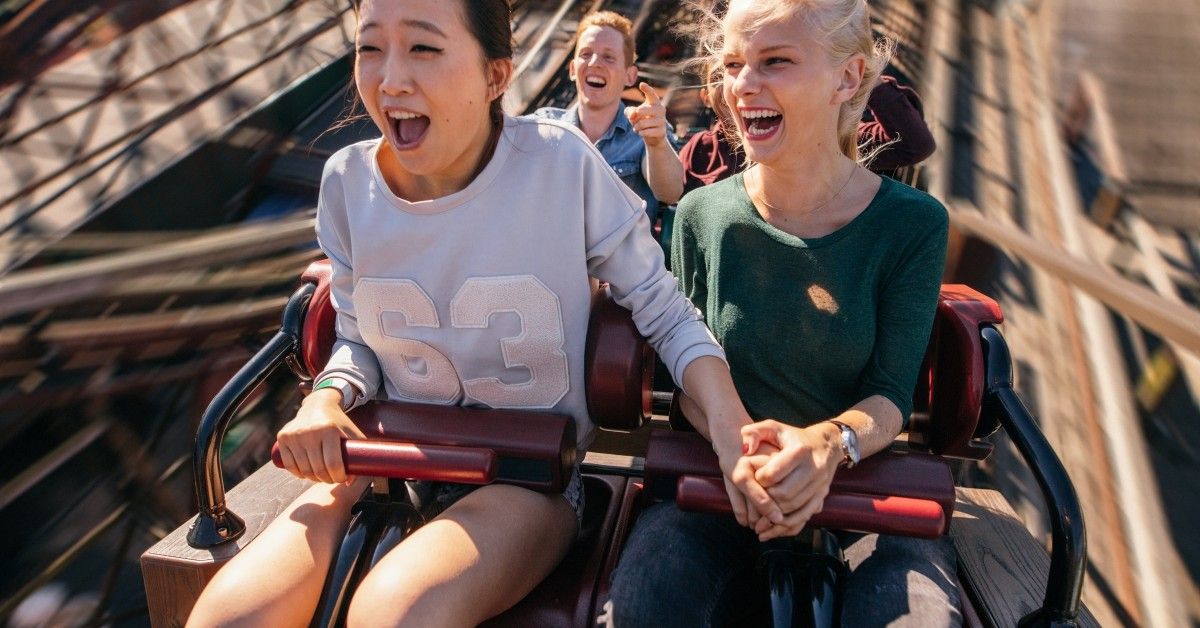When we think of roller coasters, we imagine huge structures full of railings, inversions, and pure adrenaline. While this is typically the case nowadays, the history of roller coaster innovation and implementation has been a diverse and long process. Read on to learn more about the history of roller coasters and how they have been enjoyed for the past 300 years.
Your Entertainment Experts

A Brief History of Roller Coasters
Humble Beginnings
Long before steel coasters that we take for granted today, the earliest recognition of roller coaster type attractions originated in the Russian Mountains. Russian Mountains consisted of wooden support beams that held up sloped surfaces covered in snow and ice. Participants would often ride a sled down the 50-degree slope, descending between 70 and 80-foot intervals to the bottom. Some Russian Mountains replaced the traditional sledding method with wheeled carts that participants could sit in one at a time.
Initially, this type of activity was popular and reserved for the upper class, with people such as Catherine II of Russia initiating construction projects of these Russian Mountains in palace gardens. She incorporated a pavilion near the mountains in order to partake in tea breaks after riding the attraction.
Eventually, by the mid-1800s, Russian Mountain amusement parks began to be constructed for a more wide-spread target market, especially the middle-class community. These parks experimented with design more so than the first iterations for the upper class, and eventually, the first vertical loop was created in Paris. The loop was a 13-foot, single rider attraction, and it helped change everything.
Railways
While the Russian Mountains were dominating the entertainment fields of Europe, the United States was also exploring their versions of prototype roller coasters. In the 1800s, mining companies were booming, and this led to a lot of railways that included a slope for going up and down hills. Eventually, civilians would ask to ride the railways that would provide scenic views while moving along the hills and mountains. Mining companies began charging for these scenic views, and the idea became an extra revenue stream on slow mining days.
With this idea of a “scenic railway” in place, entrepreneurs began to construct similar railway systems outside of the mining community. A gravity switchback railway was constructed at Coney Island in 1884. The following year, another railway was constructed that featured a complete circuit (meaning that it starts and stops in the same area to increase efficiency and number of passengers carried per day). This attraction quickly became the most sought after and popular attraction in the entire Coney Island area. Eventually, scenic railways began to incorporate dark tunnels and painted scenery, becoming the first versions of interactive roller coasters.
Modernity and Continued Innovation
Due to the rapid success of Russian Mountains and Scenic Railways in just a short time, roller coaster interest, dynamics, and innovation began to take flight. Inventors began experimenting again with roller coasters that featured an inverted loop. The effort was there, but the safety standards were not solidified. After numerous cases of riders getting whiplash and other injuries from the inverted portion of the rides, the ideas and attractions were once again scrapped (for now). Wooden roller coasters and scenic railways maintained popularity throughout various regions of the United States, until the Great Depression.
At the spark of the Great Depression, the demand for new roller coasters declined rapidly. This lasted until the opening of The Racer at King’s Island. The instant success of the coaster helped ignite a roller coaster renaissance, as worldwide interest began to focus in.
The Uprising of Steel
Up until 1959, every roller coaster was constructed out of wood and other materials, limiting the intensity factors of the rides. When Disneyland incorporated a full steel design for the Matterhorn, people realized the potential of steel-based coasters. Steel roller coasters can be molded and bent in much more complex forms than traditional wood, allowing for easier and safer inversions/corkscrews. These inverted coasters made a big comeback in the 1970s, sparking the age of the “modern roller coaster.”
Today’s Society
Many roller coaster enthusiasts are split nowadays on the types of rides they prefer. Adrenaline junkies are always looking for the biggest, fastest, and most gut-dropping rides available. As technology has progressed, these coasters have been able to incorporate more and more inversions and “free-fall” moments, while still allowing riders to have a safe experience. On the other side of roller coaster enthusiasts, many people are not interested in the craziest thrill-seeking aspects. These participants prefer the scenic-type rides that trace their roots to the old-time railways. Parks like Disneyland and Disneyworld have fully capitalized on the attraction-based coasters, bringing in millions of visitors each year to experience the cinematic moments.
Bringing the Attractions to You
While most roller coasters and rides are designated in one location for the entirety of their lives, Celebration Source brings the fun to your party or event! We urge you to check out our various attraction offerings, and please don’t hesitate to contact us to schedule rentals of our equipment for your upcoming event. We hope to provide you endless fun and thrills soon!
